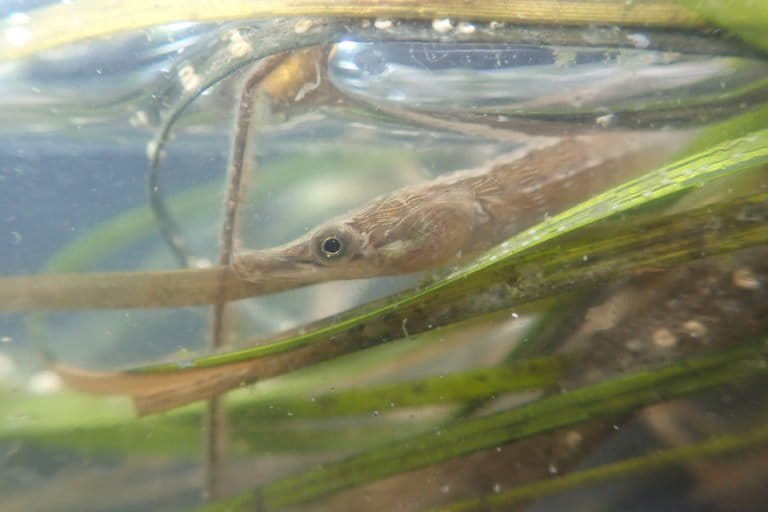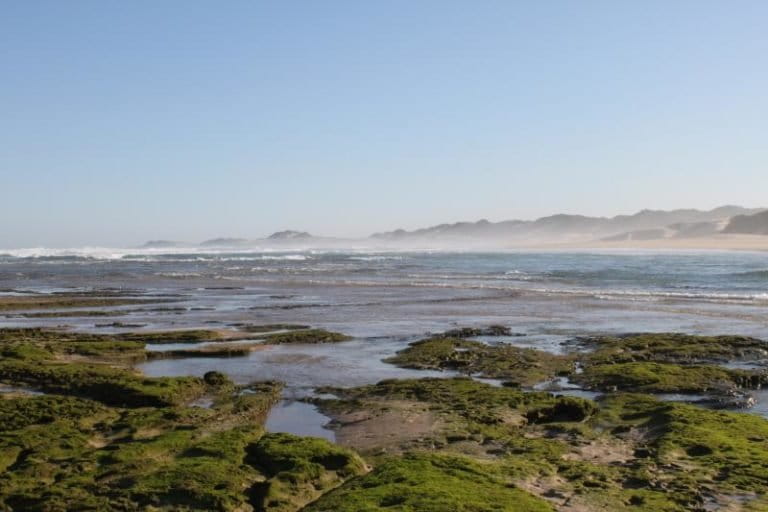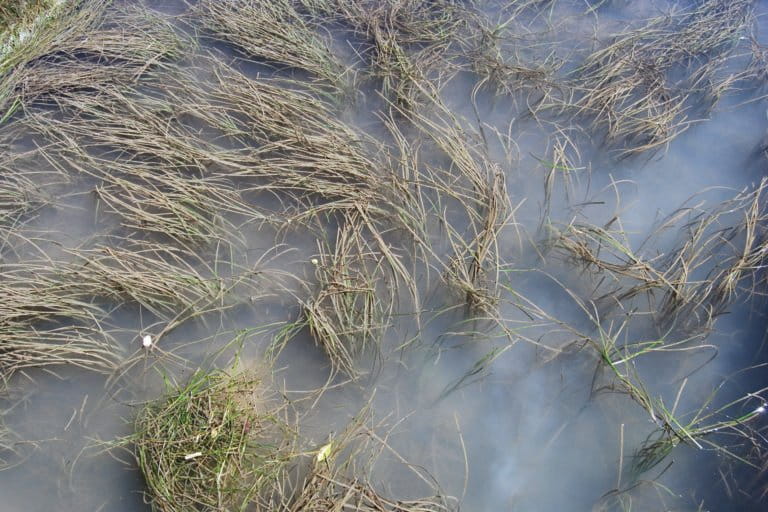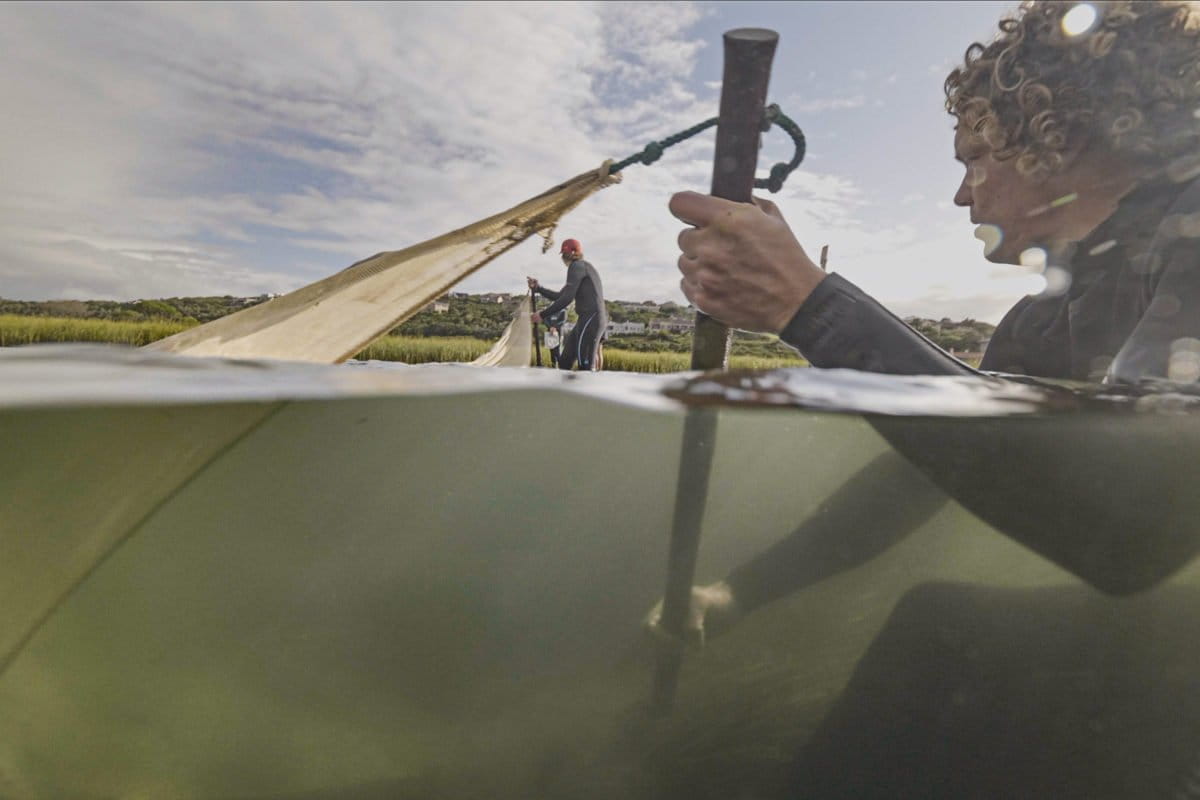- The critically endangered estuarine pipefish is known to inhabit only two estuaries on the eastern coast of South Africa.
- Recent studies are uncovering how the health of its estuarine habitat rests on a dynamic balance between freshwater inflows that support the food change, and salinity levels that promote growth of eelgrass habitat for pipefish and other species.
- Genetic analysis of the remaining estuarine pipefish populations has found low genetic diversity, highlighting a further risk to its conservation.
- Conservationists are working toward a plan to protect the species and the wider ecology of the estuaries it inhabits.
The critically endangered estuarine pipefish is known from only two estuaries on the eastern coast of South Africa. Syngnathus watermeyeri was declared extinct in 1994, only to be found again two years later. Today, the species is in a precarious position due to human and natural pressures on estuarine habitats.
Persistent drought, increasing demand for water for agriculture and domestic use upstream, and pressure on estuaries as a source of food are among the threats to the health of the Bushmans and Kariega estuaries, home to the estuarine pipefish.
Alan Whitfield, emeritus chief scientist at the South African Institute for Aquatic Biodiversity, says the pipefish is an environmental canary in the coal mine. “It’s an indicator species of when something is going wrong within an estuary. It gives us a warning signal that we are changing the system in a way that is perhaps unsustainable for other important species.”
There are more than 200 species of pipefish within the Syngnathidae family, which includes sea dragons and seahorses. These species are found across the globe and generally have tubular bodies and long snouts for feeding. Many are camouflage experts, making them notoriously difficult to study in the wild.

Hanging by a thread
The estuarine pipefish is the world’s only critically endangered pipefish species. A trio of recent studies of this cryptic species have shed new light on its prospects — and those of the estuaries it’s found in.
Floods, threats to habitat, and a limited flow of freshwater into estuaries are the primary concerns when it comes to the pipefish’s survival, according to Whitfield and other experts. The pipefish relies heavily on copepods — small zooplanktonic crustaceans — as a major source of its food.
In the late 1980s and early 1990s, the estuarine pipefish disappeared from the Kariega estuary. A series of droughts and overextraction of water from the river upstream are considered possible culprits for its demise. Declining pulses of freshwater limit the flow of nutrients into estuaries, impacting the phytoplankton that copepods feed on.
“As nutrients in the estuary decline, both the phytoplankton and zooplankton components decline with it, and the end result is a collapse of food resources for the estuarine pipefish,” Whitfield says, adding he’s worried that scenario is now repeating itself.
“Over the last few years, the Kariega estuary has been trending back to the situation that it was in during the 1980s and 1990s when there was no river flow coming in. That could once again lead to the loss of the pipefish from the Kariega estuary. So, we are really talking about a species that is hanging on by a thread.”

Estuaries under pressure
Estuaries, where seas meet rivers, are vital sources of life the world over. They are, says Nikki James, an aquatic biologist at the South African Institute for Aquatic Biodiversity, normally one of the most productive ecological areas.
In South Africa, they are also among the most threatened ecosystems. Freshwater abstraction, overfishing, habitat alteration, and pollution from urban and agricultural waste are among the common threats facing these ecosystems, combined with a low level of protection.
Lack of freshwater flow into the estuaries from upstream has changed the Bushmans and Kariega estuaries over the years. They may appear pristine, clear and in good health, but a lack of freshwater inflows means they are less productive than normal estuaries, James says.
Both estuaries would often be naturally deprived of freshwater due to drought and limited rainfall in the region. But extraction of water upstream for agriculture and other uses is denying the inflow that would normally ensure that a greater part of the estuaries would be given over to a brackish mix of fresh and seawater rather than their current marine-dominated state.
“You just need enough so that you’ve got that gradient. So, at the top it’s brackish and at the bottom, you’ve got marine water,” James says.
The effect of changes in salinity was clearly visible after flooding washed freshwater into the Kariega estuary in 2012. “The fish responded, and you got all of these little baby fish that you normally don’t record in that system, because it’s completely freshwater deprived,” James says.
“That work just highlighted how important the nutrients and the freshwater is to the normal functioning of an estuarine system.”

Improving knowledge
Scientists know more about the estuarine pipefish and its habitat than they did 30 years ago, which may both clarify and muddy the waters as far as designing an effective conservation plan. One recent study found that the two remaining populations are essentially “extended families,” according to lead author Peter Teske, a professor of marine genomics at the University of Johannesburg.
Teske’s study genotyped 34 pipefish from the Bushmans and Kariega and discovered high levels of inbreeding. “At this point it’s all about preserving what little genetic diversity is left,” he says. “Obviously, when levels of inbreeding increase further, because the pipefish are all closely related to each other, the frequency of birth defects will become a real problem.”
A study using seine-net trapping and environmental DNA suggested that the pipefish may be more common than previously thought; eDNA proved to be four times more effective at detecting the diminutive pipefish than seine netting. “We did find that with eDNA, it’s found at even more sites within these estuaries than what we find with seine netting, which suggests that it’s pretty common in these estuaries,” Louw Claassens, a marine scientist based at the University of Rhodes, told Mongabay.
Combined with a survey of S. watermeyeri’s distribution that correlated the importance of Codium, a genus of seaweed, and the eelgrass Zostera capensis, a species of seagrass, with the pipefish’s presence, Claassens suggests estuary salinity may not be the most important consideration.
“From our analysis, what we found is that the habitat was the important indicator of whether this animal occurs or doesn’t occur,” she says. “So in my mind the habitat conservation is the key fact. I wonder if the lack of freshwater flows is such a significant impact.”
While a lack of freshwater restricts food supplies for fish species, the increased salinity has proven beneficial to Z. capensis. This eelgrass, occurring in over 60 estuaries in South Africa, is a keystone species and is listed as vulnerable by the IUCN.
Aside from providing a home to pipefish, it also serves as habitat for a range of other species, including the endangered Knysna seahorse (Hippocampus capensis). Seagrasses are also known to provide other benefits such as carbon sequestration, potentially playing a role in limiting climate change, and have been shown to reduce the impacts of ocean acidification. Whether Z. capensis specifically provides these services has not been established.

Managing estuaries
The local economy also depends on healthy estuaries. Chester Wilmot, a board member of the Kenton Rate Payers Association and a local business owner, says tourism is the lifeblood of his local community, Kenton-on-Sea. Boating, recreational fishing, and simply enjoying the rivers, are all important draws for the local economy. “The whole economy is dependent 100% on tourism, we don’t have any other industry other than holidaymakers … and so when there’re no tourists, there’s less employment.”
With tourism largely shut down by the coronavirus pandemic, subsistence fishing in the Bushmans estuary became a necessity for many local people, according to Wilmot. “It’s justified and everything else, but unfortunately, the river cannot maintain the bait digging and so on that is currently taking place.”
Conserving the estuarine pipefish is tied up in preserving the health of the Bushmans and Kariega estuaries, say experts. “If we look after the pipefish, we’re looking after the estuary,” says Judy Mann, a conservation strategist at the South African Association for Marine Biological Research. She has been working with researchers to put together a conservation plan for the pipefish.
The plan, Mann says, revolves around protecting the species’ habitat, resolving the freshwater issues, and creating a captive-bred population as a “backup” in case the species becomes extinct again in the wild. Reintroducing the species to its former historic range also remains a possibility.
“We’re looking at developments around the estuaries, we’re looking at bait digging, boating, those sorts of things,” Mann says. Resolving other issues such as pollution and freshwater flows will involve conversations with local and provincial authorities, she says.
Right now, those conservation efforts are only at the beginning, Mann says, and were stalled by the pandemic.
The pipefish population in the Kariega remains vulnerable to flooding, which could wipe out the available habitat. Such floods extinguished the populations in the East and West Kleinemonde estuaries. On this front, there is little that can be done.

James’s research indicates that increased freshwater flow would help to restore some of the overall balance to the estuaries, returning them closer to a true estuarine system. But more freshwater flow into the estuary would likely have a negative knock-on effect for the pipefish’s habitat by reducing water clarity.
It’s all about finding a balance, says Teske, between food and habitat.
That is the ultimate concern for Wilmot: the overall health of the estuaries. For him, they are “national assets.”
“We are a thousand percent dependent on the health of our rivers and it’s absolutely vital that care is taken over them,” he says. “I believe that a lot more emphasis needs to take place on the longevity of the whole rivers as an entirety.”
Citations
Ntshudisane, O. K., Emami-Khoyi, A., Gouws, G., Weiss, S., James, N. C., Oliver, J., … Teske, P. R. (2021). Dietary specialisation in a critically endangered pipefish revealed by faecal eDNA metabarcoding. bioRxiv. doi:10.1101/2021.01.05.425398
Weiss, S., Emami-Khoyi, A., Kaiser, H., Cowley, P. D., James, N. C., Jansen van Vuuren, B., … Teske, P. R. (2022). The last two remaining populations of the critically endangered estuarine pipefish are inbred and not genetically distinct. Frontiers in Marine Science, 8. doi:10.3389/fmars.2021.756595
Olisah, C., Adams, J. B., & Rubidge, G. (2021). The state of persistent organic pollutants in South African estuaries: A review of environmental exposure and sources. Ecotoxicology and Environmental Safety, 219, 112316. doi:10.1016/j.ecoenv.2021.112316
Whitfield, A. K., Attwood, C. G., Cowley, P. D., Lamberth, S. J., & Mann, B. Q. (2020). No-take estuarine-protected areas: The missing armour for the conservation of fishes. KOEDOE – African Protected Area Conservation and Science, 62(1). doi:10.4102/koedoe.v62i1.1648
Nodo, P., James, N. C., Childs, A., & Nakin, M. D. (2018). Response of demersal fish assemblages to an extreme flood event in a freshwater-deprived estuary in South Africa. Marine and Freshwater Research, 69(2), 253. doi:10.1071/mf17096
Nester, G., Heydenrych, M., Berry, T. E., Wasserman, J., Richards, Z., White, N., … Claassens, L. (2021). Environmental DNA detects critically endangered South African estuarine pipefish Syngnathus watermeyeri. Zenodo. doi:10.5281/zenodo.5481837
Claassens, L., Villiers, N. M., Seath, J., & Wasserman, J. (2021). Distribution and density of the critically endangered estuarine pipefish across its range – implications for conservation. Aquatic Conservation: Marine and Freshwater Ecosystems, 32(1), 28-41. doi:10.1002/aqc.3742
Adams, J. B. (2016). Distribution and status of Zostera capensis in South African estuaries — A review. South African Journal of Botany, 107, 63-73. doi:10.1016/j.sajb.2016.07.007
Ricart, A. M., York, P. H., Bryant, C. V., Rasheed, M. A., Ierodiaconou, D., & Macreadie, P. I. (2020). High variability of Blue Carbon storage in seagrass meadows at the estuary scale. Scientific Reports, 10(1). doi:10.1038/s41598-020-62639-y
Wahl, M., Schneider Covachã, S., Saderne, V., Hiebenthal, C., Müller, J. D., Pansch, C., & Sawall, Y. (2017). Macroalgae may mitigate ocean acidification effects on mussel calcification by increasing pH and its fluctuations. Limnology and Oceanography, 63(1), 3-21. doi:10.1002/lno.10608
Banner image: Searching for the estuarine pipefish. Image courtesy of Jason Boswell.
FEEDBACK: Use this form to send a message to the author of this post. If you want to post a public comment, you can do that at the bottom of the page.
